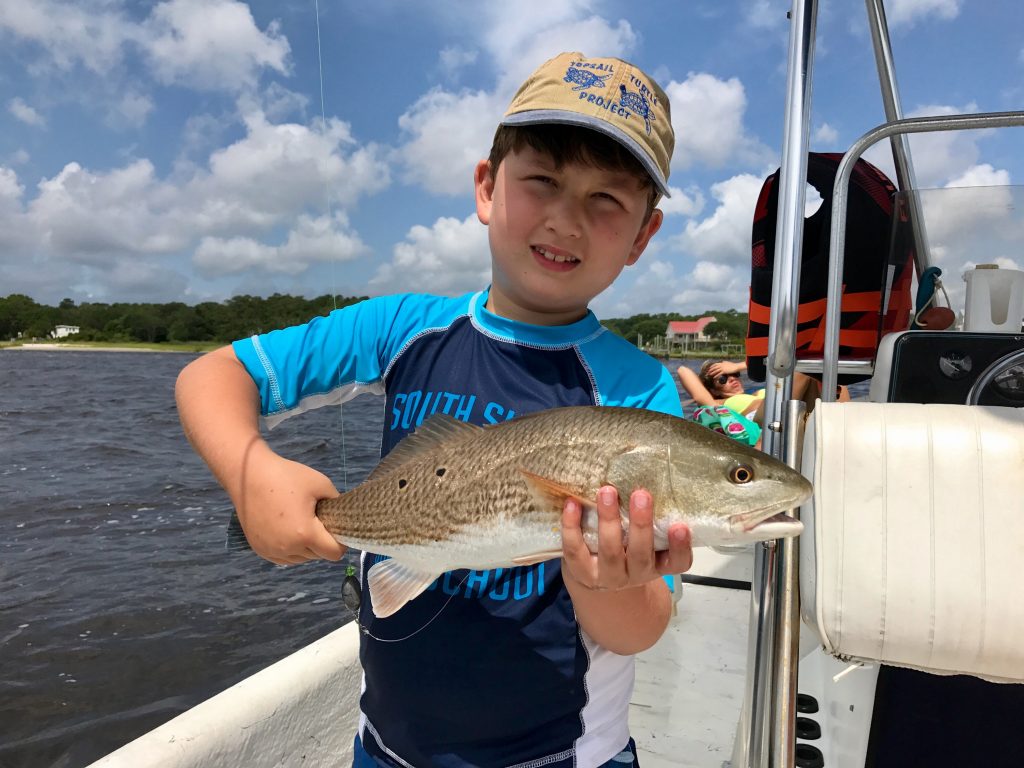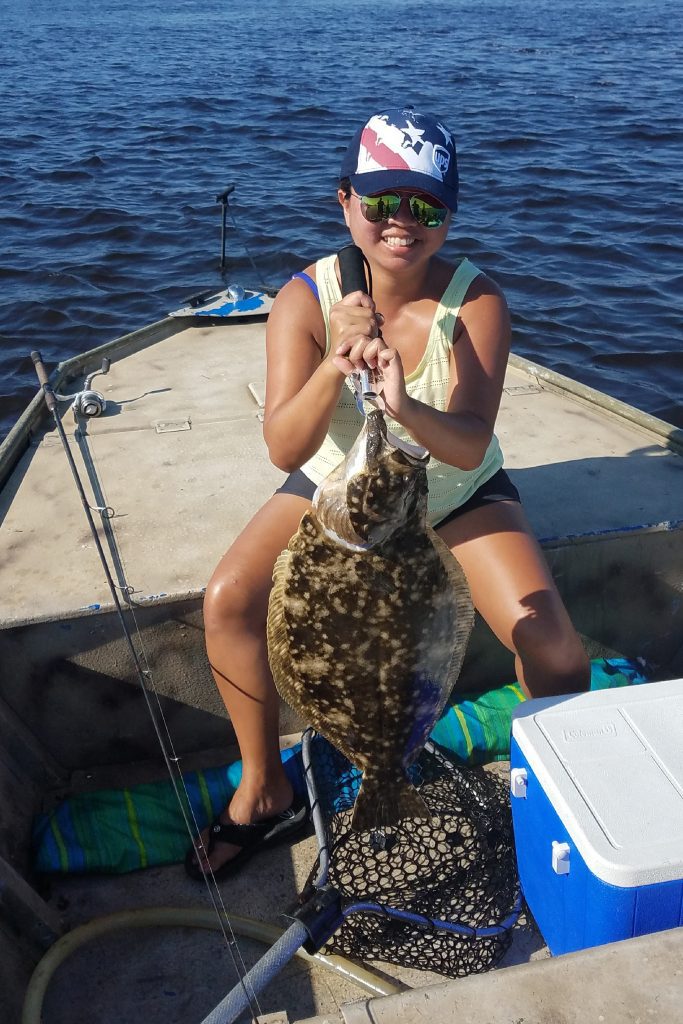Carolina Beach – July 6, 2017
Red, of Island Tackle and Hardware, reports that the inshore flounder bite has stayed steady. Tossing live pogies on Carolina rigs near docks in the waterway and in the Cape Fear River has been best for the flatfish. Most fish have been between 2-3 lbs., but a few weighed in have been between 5-7 lbs.
Red drum have also been mixed in some of the same areas as the flounder. Most fish are in the 19-23” range, with a few upper-slot fish in the mix. Throwing topwater plugs around scattered oyster bottom in the early mornings has also been a great way to target the reds.
Speckled trout fishing near marsh points in the river and creek mouths in the waterway has put limits in the boat. Topwater lures like the Zara Spook Jr. in black and silver have been the best way to target the larger specks early in the morning. Live shrimp under float rigs also works well for trout. Most trout are in the 2-3 lb. range, with the occasional citation-sized fish mixed in.
Sheepshead and black drum have also been feeding well around area docks and bridge structure. Fishing around the Snows Cut Bridge with live fiddler crabs has been best for the sheepshead, while most of the black drum have been feeding better in the lower Cape Fear River on fresh shrimp.
Nearshore anglers trolling Clarkspoons or live baits are having success landing spanish, kings, and false albacore. Targeting nearshore reefs and bait pods has been the ticket for these species.
In the 10-25 mile range, there are dolphin, sailfish, and blackfin tuna holding near live bottom and structure. Trolling skirted ballyhoo has been the best way to boat all three species.
Fishing the bottom around the 20 mile mark has kept those dropping cut baits busy. Black sea bass, grouper, and snapper have all been feeding well.
Christian, of Seahawk Inshore Fishing Charters, reports that anglers looking for redfish in the shallow water creeks have been successful using mud minnows on Carolina rigs. Most of the reds have been between 18-21”, and many days have yielded double digit results. A few over-slot fish have been in the mix as well, and the falling tide all the way to full low tide has been the best time to target the reds.
Those searching for flounder in the lower Cape Fear River creeks and bays have found fish from 12-13” consistently, and a few 16-21” fish have been landed as well. Targeting deep pockets near oyster structure while using mud minnows pinned on Carolina rigs has been the key to boating good numbers of flatfish.

Logan Satorie (age 7), of Wilmington, with a 17″ red drum caught and released in the Carolina Beach ICW. The drum fell for live pogie.
Greg, of TopWater Guide Co., reports that red drum are still holding around waterway docks and along marsh edges in the waterway. Fishing live mud minnows on Carolina rigs has been the best method for hooking limits of reds, but some fish have preferred fresh shrimp. On the flats, fish are also willing to hit a topwater plug (like the MirrOlure She Dog) first thing in the morning.
Anglers have had success with high numbers of flounder in the waterway. Most fish have been just under-sized, but there have been a few fish around the 18” mark landed as well. Fishing live pogies or finger mullet rigged on a Carolina rig has worked best. The flounder have been moving daily, so covering a good amount of water has been vital to boating good numbers of fish.
Black drum are feeding well in the Cape Fear River, and most fish are being caught on fresh shrimp on Carolina rigs. Oyster and rock structure has held the best numbers of fish, but be prepared to weed through the trash fish first.
Rod, of OnMyWay Charters, reports that the nearshore spanish bite has been better when running south out of Carolina Beach Inlet towards the High Rock area. Trolling Clarkspoons has been the ticket to landing larger numbers of fish.
Kings in the 5-15 lb. range have been feeding well in the 7-25 mile range. Trolling Drone spoons in blue and silver, pink and silver, and chartreuse and silver have been the hot colors for kings, and using #2 planers with 80 yards of 80-100 lb. test leader has been the most effective method. Targeting live bottom, ledges, and other nearshore structure has been the most productive way to box the kings.
Mahi in the 7-8 lb. range have been landed as close as 10 miles outside of Carolina Beach Inlet. Most fish have been landed while slow trolling pogies for kings. Out to the 20-25 mile range, larger mahi to 20 lbs. have been boated trolling ballyhoo. Fishing for mahi has been best during the first few hours of light.
Fishing the bottom in the 22-40 mile range has produced plenty of black sea bass, pinkies, vermilion snappers, grunts, and triggerfish for those dropping cut baits.
The Gulf Stream water temperature is holding right around 83 degrees, and mahi have been feeding well. Trolling with pin-rigged ballyhoo, as well as Blue Water Candy sea witches, has been the best method for the mahi.
Jesse, of Ocean Stinger Fishing Charters, reports that anglers venturing to the Gulf Stream have had success with mahi and blackfin tuna while trolling small skirted ballyhoo. Fishing the 40-60 fathom range with skirt rigs in blue/white and black/purple has been working best. Most fish have come off the shotgun or long outrigger set-up.
The occasional sailfish has been in the mix as well. The sailfish have been coming into the dredges and spreaders bars, and dropping a pitch bait to them has worked best.
In the 25-35 mile range, the kings and mahi have been plentiful. Most mahi have bit on black/purple flying fish skirt rigs with 1 oz. heads. The water in this range has been darker, so darker color skirts and rigs tend to work best.
Nearshore tolling in the 1-5 mile ran

Oubon Emmons, of Boiling Spring Lakes, NC, caught this 7 lb. 6 oz flounder on a live mullet near Snows Cut.
ge is producing plenty of spanish action. Trolling 00 Clarkspoons in silver and pink/silver on #1 planers has worked best. Using 40′ of 20 lb. fluorocarbon leader has been the key to high numbers of hook-ups.
Eileen, of Kure Beach Pier, reports that those fishing fresh shrimp on bottom rigs have been connecting with good numbers of black drum and sea mullet. Anglers tossing Gotcha plugs and Stingsilvers have landed spanish and bluefish in the 2-3 lb. range.
Tina, of Carolina Beach Pier, reports that anglers tossing Gotcha plugs have been landing plenty of spanish and bluefish early in the morning. Throughout the day, those fishing fresh shrimp on the bottom have had luck catching sea mullet and croaker.
